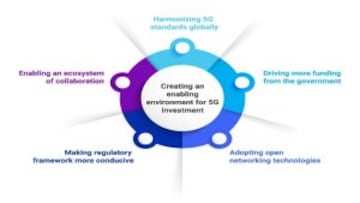
5G has the potential to transform the world like never before. Triggered by what is unfolding from the last 18 months, 5G can actually take the world out of the economic rubbles and set it on course for future growth. The technology can make a difference of up to USD 3.5 trillion to the world’s economy by 2035. And the positive impact it will bring to society through uninterrupted connectivity is unmeasurable. However, for all that to happen, the world, especially India, needs to press on the pedal to invest in 5G network rollouts.
5G needs massive investment and fast!
The need to deploy and scale 5G use cases will require significant changes in network infrastructure. Network creators will have to invest in every aspect of the network right from the spectrum and Radio Access Network (RAN) to transmission and core networks. The investment in India alone will be about USD 30 billion. For 5G to unleash its full potential, these investments need to happen fast. The expected delay in the 5G rollouts is going to hurt the long-term prospects of several sectors in India. For example, telehealth use has increased 38X from the pre-COVID-19 baseline and 100 million students have enrolled in the last six months for online education. This momentum will only surge with widespread 5G coverage.
Investments are flowing, but hurdles remain
Demand related to new 5G use cases has triggered investments by telcos and other network creators. Telcos across the world have raised their CAPEX to expedite the 5G rollouts. Already, close to 70 operators have been investing (in the form of trials, planned or actual deployments) in public 5G networks while almost 400 are investing in 5G licences, trials or deployments. However, there still remains hesitancy among some telcos to prioritize 5G investments. Some of the reasons are:
Upfront CAPEX commitments: Deploying 5G networks require billions of dollars in the upfront cost that operators will have to incur before offering the first GB of 5G data. To give you the perspective on the magnitude of investment, the 5G rollout in Delhi, India, can cost a telco USD 1.15 billion. At a time when telcos, especially in India, are under some financial duress, the upfront investment can be a handful.
Locally curated 5G standards: In many emerging markets, authorities have developed homegrown 5G standards that don’t harmonise with global standards supported by the 3GPP. Homegrown standards often pose many challenges related to hardware changes, increased time to market, smartphone overheads and interoperability. For example, if 5G chip standards are different in every country, a global chipset maker will need to make different chips according to different standards, which will increase the cost and time to market.
Regulatory frameworks: One of the other prominent reasons behind telcos deferring their investments in 5G is regulatory frameworks. In a number of markets, especially the emerging ones, the regulatory framework is often not uniform. The regulations, standardised processes and bureaucratic hurdles often come in the way of network rollouts that defeat the entire purpose of the investment.
Monetization of 5G use cases: The business case and economics of 5G remain unclear in some geographies, possibly delaying full-scale investments. The stagnation of ARPUs across the world implies that recouping the investments can take more time. Also, some CSPs are not exactly aware of 5G’s monetization opportunities that go beyond simply charging consumers more for faster data.
The hurdles need to be eliminated
To lead the 5G revolution, network providers need an enabling environment for them to make large scale investments. Here are some of the things that can be done to create that:
5G standards need to be harmonized globally: There need to be dedicated efforts towards harmonizing the global standards for 5G technical features. The adoption of globally harmonised standards will give a competitive playing field across vendors and providers across geographies. The adoption will also attract the businesses to set up their shops with the confidence of serving domestic as well as international markets.
Governments need to play a more active role in funding: In countries where 5G is flourishing, governments intervened in developing infrastructure through aggressive funding initiatives. In the US, the Federal Communications Commission adopted an Order establishing the 5G Fund for Rural America (“5G Fund”), which will make available up to USD 9 billion in federal subsidies over 10 years. This has played a part in telcos raising their CAPEX for widespread 5G coverage. In emerging markets, governments should lend a helping hand to telcos. A budgetary outlay for digital infrastructure will not only help in making the world 5G ready but will also bolster initiatives such as building broadband highways, connecting rural areas, modernising government networks and so on.

Mindset needs to move towards open networking: Open source is the future of networks and there need to be concentrated efforts for its greater adoption. It can open up new ways to deploy and operate wireless networks, foster innovation and competition, and can bring substantial CapEx and OpEx savings to operators. This approach has brought significant savings ranging from 30-40 percent in total cost of ownership (TCO).
Regulations need to be more conducive: A conducive regulatory framework always sends the right signals to the investors. Regulators and legislators need to come together to reduce regulatory burdens such as Adjusted Gross Revenue, spectrum pricing, and spectrum usage charges on telcos. A comprehensive long term policy mapping should also be done to promote domestic manufacturing and research and development. This framework should be made by the authorities in collaboration with network operators and private players.
An ecosystem of collaboration needs to be built: There is a strong need for more collaboration models to enable an environment of increased investments. We can already see some global coalitions and initiatives such as TIP, O-RAN ALLIANCE, Evenstar among others bringing private players together to build the networks of tomorrow. There should be more collaborations across governments, regulators, academia to create newer business opportunities and innovative business models attracting more investments.
For 5G to truly transform the world, it has to go across the world. While most of the global telecom community is investing in the 5G revolution, there are still few who are hesitant. By enabling the right environment for them and breaking financial, regulatory and mindset barriers, we can drive more strategic investments in making 5G widespread.
The author is Ankit Agarwal, Managing Director, STL. The views expressed here are personal.
(Edited by : Priyanka Deshpande)
First Published: Nov 25, 2021 4:05 PM IST
Check out our in-depth Market Coverage, Business News & get real-time Stock Market Updates on CNBC-TV18. Also, Watch our channels CNBC-TV18, CNBC Awaaz and CNBC Bajar Live on-the-go!


PM Modi says great men like Nehru and Ambedkar were against reservation based on religion
Apr 28, 2024 6:41 PM
Exclusive | Congress has turned Bengaluru from 'tech hub to tanker hub': PM Modi
Apr 28, 2024 6:18 PM
Modi Interview | Here's what the Prime Minister said on inheritance tax
Apr 28, 2024 6:05 PM
Congress appeals to EC to increase voting duration, says media report
Apr 28, 2024 4:04 PM

